Dong Ba Market
Dong Ba Market, a traditional shopping destination combined with attractive tourism, is an inseparable icon when exploring the ancient capital of Hue. With the diversity of traditional stalls and cuisine, Dong Ba Market promises to offer you unique experiences in history, culture, and local cuisine. Join Deluxe Group Tours to immerse yourself in this vibrant market in the Hue city.
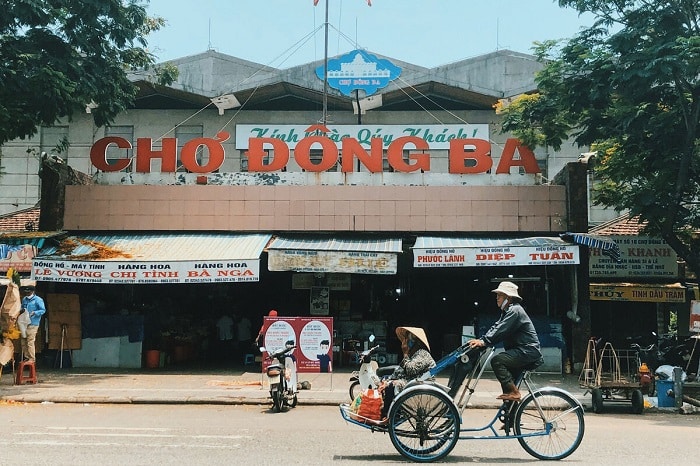
The formation of Dong Ba Market
Dong Ba Market began to take shape during the reign of King Gia Long, located outside the Chanh Dong gate. However, after the events of the capital city of Hue in 1885, the French colonialists destroyed the market. In 1887, when King Dong Khanh ascended to the throne, the market area was reconstructed and named Dong Ba.
In 1899, King Thanh Thai relocated Dong Ba Market to its current location. With over 100 years of existence, the market has undergone numerous renovations. Covering an area of more than 47,600 square meters, Dong Ba Market stretches from Gia Hoi Bridge to Trang Tien Bridge. One side of the market runs along the picturesque Perfume River, while the main face fronts Tran Hung Dao Street.
Explore Dong Ba Market’s areas
Dong Ba Market, with over 2,700 stalls and more than 1,800 business households, is divided into a three-floor structure.
The first floor is the food area, which is also the most attractive area where you should spend a lot of time. As soon as you step in, you can immediately smell the aroma of various foods, from dried to fresh. This bustling market in Hue is undoubtedly incomplete without specialty stalls such as shrimp paste, sour shrimp (fermented shrimp paste), fermented clam paste, Cô Ri fermented paste specialty, and even various types of cakes. Here, don’t hesitate to ask to purchase it so you can enjoy it right on the spot or even take it home. However, you should also note that if you buy them to take home by plane or train, pack them carefully as most of them have a strong smell.
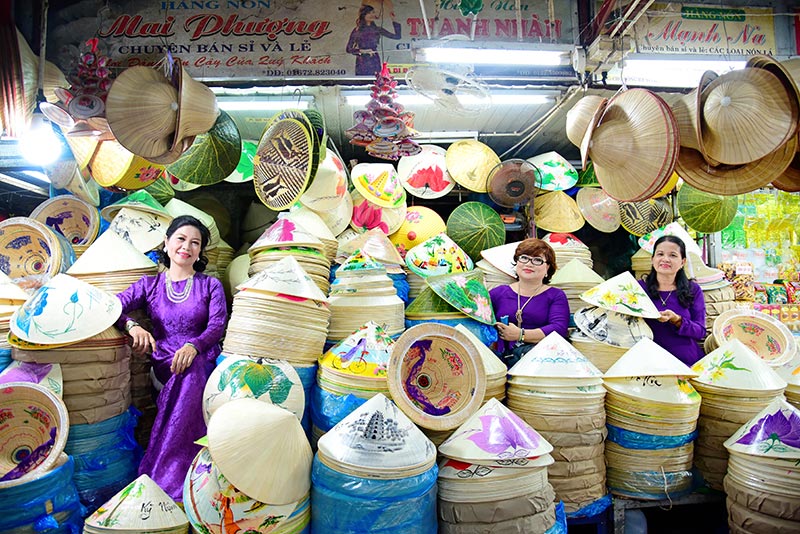
Dong Ba Market
The second floor is the area dedicated to handicrafts and fine arts. Upon reaching the second floor, you will immerse yourself in numerous handicraft products. Here, you will see items skillfully crafted by the hands of the locals, such as traditional Hue conical hats, unique hand-woven crochet bags, rustic pottery jars, simple clay vases, intricately carved plates depicting famous landmarks of Hue, and more. Additionally, there are meticulously woven bamboo products, such as popular trellis items. In this area, you can leisurely explore and purchase souvenirs.
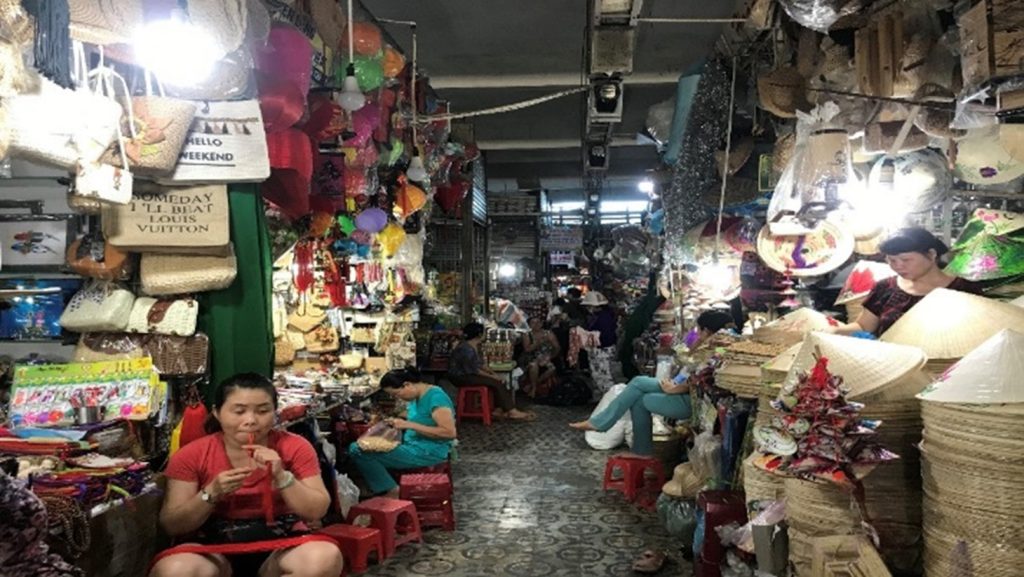
The third floor is also the garment and clothing area. On this highest floor, you will find a section displaying all kinds of clothing and fabrics. Here, you will feel like you’ve stepped into a colorful land with vibrant outfits, elegant traditional dresses, and cheerful seamstresses welcoming each customer with a smile

Dong Ba Market highlight activities
1. Experience shopping exploration
Dong Ba Market will be a shopping paradise for you, as the market area boasts all kinds of products, from souvenirs to food and clothing. When you visit the market, you can enjoy and purchase exquisite products that carry the rich cultural essence of the ancient capital region, such as royal tea, conical hats, wooden engraved products, fermented shrimp paste, and dried lotus seed. You will also be captivated by the experiences within the local food of the market, featuring dishes like beef noodle soup, and baby basket clams rice (com hen).
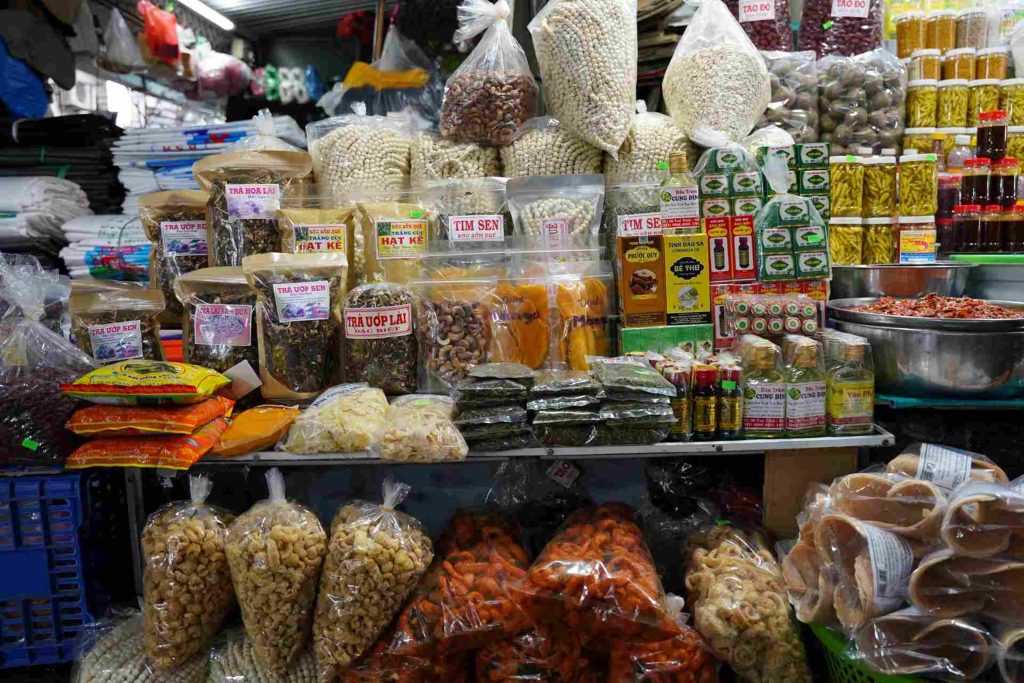
lotus seed
In addition, you can choose essential items like clothes and fabrics as gifts. Hue is renowned for the unique fabrics used to make Ao Dai, which are adorned with traditional Vietnamese patterns like lotus flowers, imperial motifs, and pagodas. Alongside these, there are exceptional handicrafts such as conical hats, intricate jewelry, and ceramics. Although not comparable to Bat Trang ceramics, Phuoc Tich ceramics are also a perfect choice. This village is one of the best-known traditional handicraft villages in Vietnam.
Read More: Hue Cuisine – Exploring the Capital of Vietnam Gastronomy
2. Enjoy Hue specialities
When it comes to Hue, it’s impossible not to mention the Central Vietnamese cuisine with its heartwarming dishes. When you visit Dong Ba Market, you will find yourself in a culinary paradise with numerous budget-friendly eateries that fill the air with enticing aromas. There’s everything from beef and pork hock noodle soup, grilled pork and rice vermicelli, and fermented pork roll, not to mention various kinds of savory cakes like bloating fern–shaped cake (beo cake), Vietnamese tapioca dumplings (loc cake), flat steamed rice dumplings (nam cake), and a multitude of characteristic Hue-style desserts.
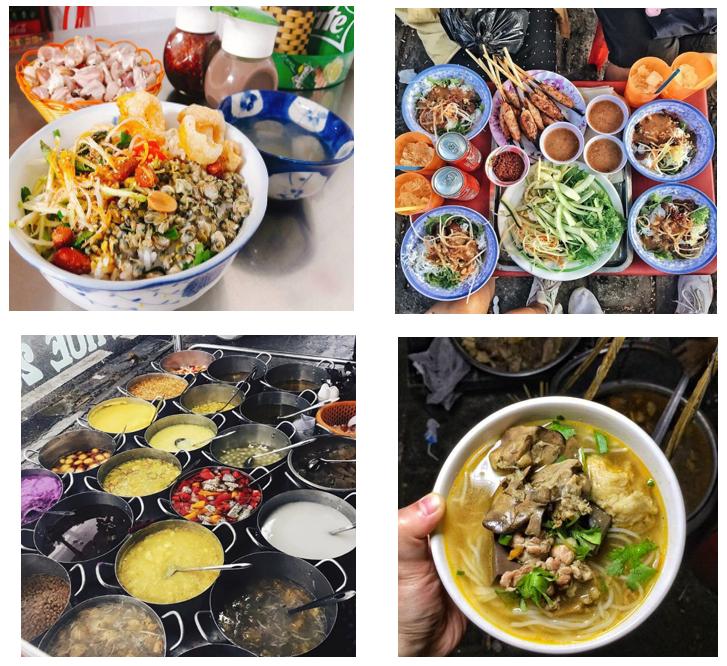
Most of the dishes at Dong Ba Market are prepared and sold by local Hue residents, imparting a distinct flavor. The prices are reasonable, ensuring food safety and hygiene. Each serving here ranges from 10,000 to 30,000 Vietnamese Dong.
Read More: A Culinary Journey in Hue: Discovering the variety of Hue food
Top 7 Must-Try Dishes When Visiting Dong Ba Market, Hue City :
- Bun Bo Hue: A delicious noodle soup with fragrant broth, filled with the flavors of beef, vermicelli, and various spices.
- Banh Khoai: A type of Hue pancake, flavorful and can be enjoyed with a variety of fresh vegetables.
- Banh Beo: Small, lightweight steamed rice cakes typically served with minced shrimp and a savory dipping sauce.
- Banh Loc: Thin, translucent dumplings made from tapioca starch, filled with shrimp and pork.
- Hen Xuc Banh Trang: Baby clams sautéed and served on rice paper, accompanied by spices and fresh herbs.
- Oc Luoc: Boiled snails, a popular and flavorful seafood option.
- Che Hue: A traditional dessert in Hue, often featuring ingredients like mung beans, rice balls, coconut milk, and assorted fruits in a sweet soup.
3. Take Memorable Photos

The design of Dong Ba Market, up until the present day, still carries nostalgic and antique colors with very traditional beauty. Here, you will step into a market space reminiscent of the late 20th century, with stalls connected one after another in simple and intimate wooden stalls. The market gate with the prominent words “Chợ Đông Ba” is the most checked-in place by many tourists. People and vehicles bustling about, the lively atmosphere of trading, yet still carrying a somewhat melancholic touch, which has become the distinctive color of Hue. So, when you come here, just “perform” a graceful gesture, gently take a step, or contemplatively admire the streets and alleys, and you’ve already captured a stunning photo.
Dong Ba Market Travel Experience
1.Location
Dong Ba Market is one of the largest markets in Hue, located on Tran Hung Dao Street, along the picturesque banks of the Perfume River. Its convenient central location makes it easily accessible for you to visit and explore Hue during your sightseeing days by any means of transport, whether a motorbike, taxi, or private car.
2 Best time to travel
Because the market area is always crowded and the paths between stalls are somewhat narrow, February–March or August–September are perfect times to fully explore the market. You won’t be bothered by the harsh sun or the prolonged rains in Hue.
3 Dong Ba Travel Tips
- The market operates from 5:00 to 19:00, so you can comfortably arrange your travel schedule.
- It’s advisable to wear comfortable clothes and flat shoes when exploring the market because you’ll be doing a lot of walking, and dressing comfortably with flat shoes will provide convenience.
- Visit the market in the morning to buy the freshest produce, but in the afternoon, bargaining is easier.
- The food stalls are also open in the afternoon.
- Even if it’s your first time at the market, feel free to suggest a reasonable price and negotiate a bit with the seller to get your favorite items at the lowest price.
Read More: Update the entrance fee for visiting attractions in the charming city of Hue
4 Recommend nearby tourist destinations
From Dong Ba Market, you can easily move on to visit nearby places such as:
- Truong Tien Bridge: From the market to Truong Tien Bridge, it is only 750 meters. The bridge spans the Perfume River, connecting the South and North banks, and is considered a representative symbol of Hue, attracting many tourists. You can stroll on the bridge and admire the picturesque Perfume River, or explore the pedestrian street under the bridge.
- Hue Imperial City: About 1.4 km from Dong Ba Market is the Hue Imperial City, also known as the Hue Citadel. This monumental structure in Hue has a construction history spanning over 300 years, showcasing remarkable craftsmanship. The Imperial City was the living and ruling place of the Nguyen dynasty kings and has been recognized by UNESCO as a World Cultural Heritage site.
- Thien Mu Pagoda: Moving about 5 km further to the north, you can visit the sacred and mysterious Thien Mu Pagoda. Situated on Ha Khe Hill, along the famous Perfume River with many mystical legends, the pagoda features impressive architectural structures that everyone would like to explore.






